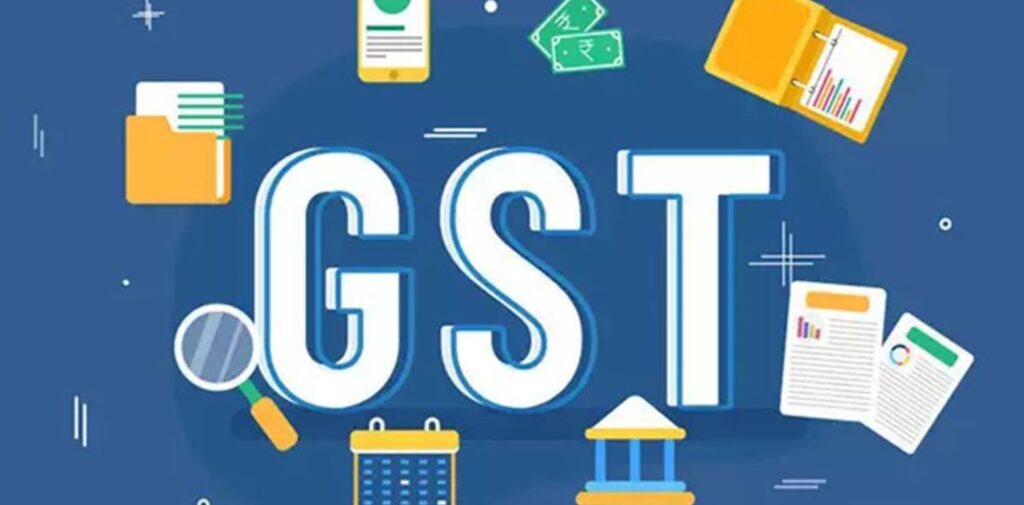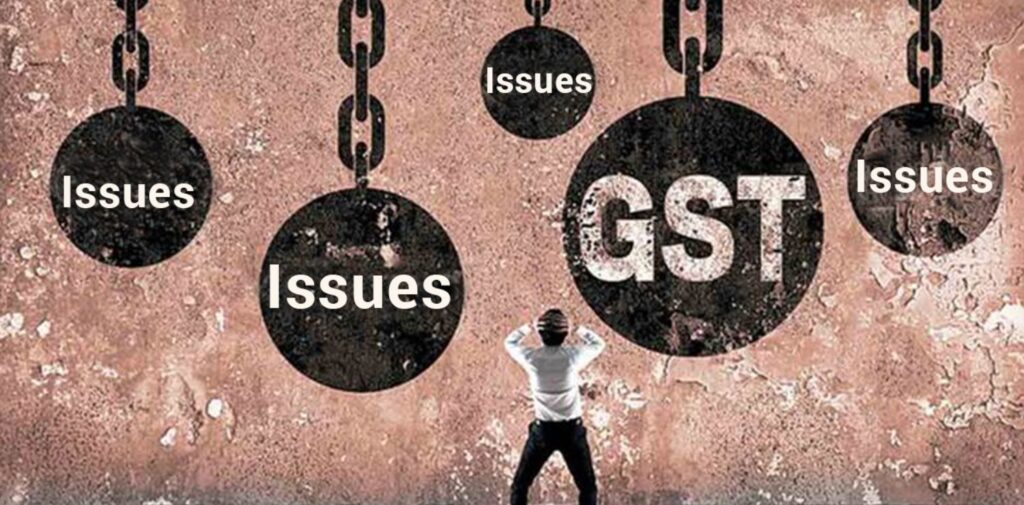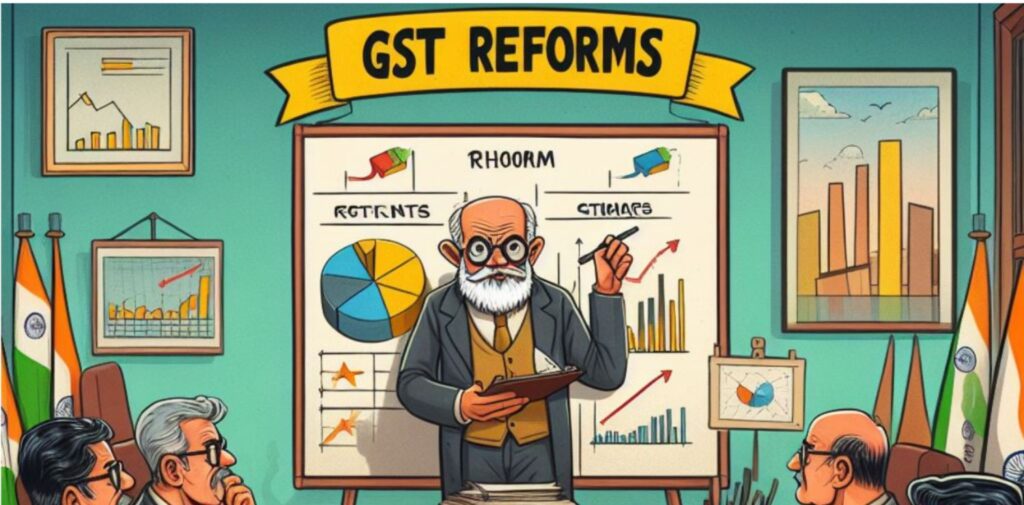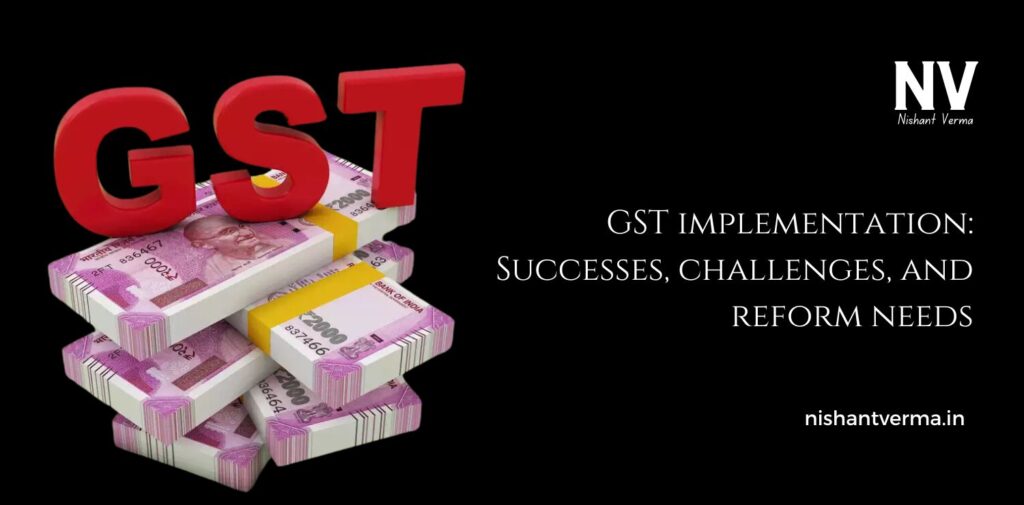GST is a consumption-based tax, which means it is paid by the consumer, but businesses are responsible for collecting and sending the tax to the government. It is a way of ensuring that the tax system is transparent and uniform across the country. GST was expected to help boost the economy by making the process simpler and reducing the chances of tax evasion.

Successes of GST Implementation
Since its implementation, GST has had several positive impacts on India’s economy. Some of the main successes are:
- Simplified Tax Structure: Before GST, businesses had to deal with many different types of taxes, and the rules were different in every state. This made it difficult for companies, especially those selling products in multiple states, to keep track of everything. With the introduction of GST, the tax system became simpler. Now, there is only one tax that applies across the country. This has made it easier for businesses to manage their taxes and helped reduce the paperwork involved.
- Boost to Economic Growth: One of the main goals of GST was to increase economic growth by promoting trade and reducing the barriers between states. Before GST, businesses had to pay taxes when moving goods from one state to another, which increased costs. GST removed these barriers, and now goods can move more freely between states without extra taxes. This has made trade easier, improved supply chains, and helped businesses grow.
- Increased Tax Collection and Compliance: GST has helped improve tax collection in India. Earlier, many businesses tried to evade taxes, and the government had difficulty collecting them. With the GST system, businesses need to keep detailed records of their transactions, making it harder for them to evade taxes. As a result, the government has seen an increase in the number of businesses paying taxes and in the total tax collection.
- Formalization of the Economy: GST has encouraged many small and informal businesses to become part of the formal economy. By making the tax system more transparent, GST has made it easier for businesses to register and pay taxes. This has helped reduce the number of businesses working in the “black market,” where taxes were not paid. As a result, more businesses are now part of the formal economy, which is a positive step for the country’s growth.
- Reduction in Cascading Taxation: Before GST, businesses paid taxes on taxes, which led to what is called “cascading taxation.” For example, if a manufacturer paid tax on raw materials and then sold the finished product, they had to pay tax again on the sale. This made goods more expensive. With GST, businesses can claim tax credits for the taxes they have paid on inputs, reducing the effect of cascading taxes. This has made goods and services cheaper for consumers.

Challenges Faced by GST
Despite the many successes, GST has faced several challenges since it was implemented. Some of the most common problems include:
- Complex Compliance Requirements: One of the biggest challenges businesses face with GST is the complicated compliance process. Although GST was introduced to simplify the tax system, the new system requires businesses to file detailed reports online and keep track of their transactions. This can be difficult for small businesses, which may not have the resources to handle the complicated paperwork. The tax system’s digital nature has also been difficult for many businesses, especially in rural areas, where internet access may not be reliable.
- High Tax Rates: While GST is meant to be a simple and uniform tax, many people feel that the tax rates are too high. The GST system divides goods and services into different categories, and each category has its own tax rate. Some goods, like luxury items, are taxed at a higher rate, while essential items may have lower rates. However, for many businesses and consumers, the higher tax rates on certain products have increased costs and made it harder to afford goods.
- Issues with Technology and System Failures: GST relies heavily on technology, as businesses need to file their taxes online using the GST portal. Unfortunately, the technology behind GST has not always worked smoothly. There have been frequent system failures, glitches, and delays, making it difficult for businesses to file their returns on time. These technical issues have caused confusion and frustration for businesses and tax officials alike.
- Challenges for Small Businesses: Although GST has helped bring small businesses into the formal economy, many of them are still struggling with the new system. Small businesses that were used to paying taxes in a simpler manner now find themselves dealing with complicated procedures and higher compliance costs. Many small businesses also have trouble understanding the GST rules and regulations, which can lead to mistakes and penalties.
- Inconsistent Implementation Across States: Although GST is meant to be a uniform tax system across India, different states have implemented it in slightly different ways. Each state has its own tax authorities, and some states have been slower than others in adapting to the new system. This has created confusion for businesses that operate in multiple states, as they have to follow different rules in different parts of the country.

Reform Needs for GST
While GST has been a major step forward, there are several areas where reforms are needed to make the system more efficient and effective.
- Simplifying the Tax Structure: One of the most important reforms needed is to simplify the tax rates. Right now, there are multiple tax slabs for different categories of goods and services, which makes the system complicated. The government should consider reducing the number of tax slabs and making the rates more uniform. This would help businesses understand the system better and reduce confusion.
- Improving Technology and Systems: The GST portal needs to be improved to make it more user-friendly and reliable. The government should invest in better technology to ensure that businesses can file their taxes smoothly without technical glitches. Providing more training and support for businesses, especially small ones, can also help them adapt to the digital nature of GST.
- Reducing Compliance Burden for Small Businesses: Small businesses face the most difficulty with GST compliance. The government should introduce easier procedures for small businesses, such as simplified reporting requirements and lower compliance costs. This would help small businesses focus on growing their companies rather than worrying about complicated tax rules.
- Lowering Tax Rates for Essential Goods: While luxury goods should be taxed at higher rates, essential items like food, medicines, and daily necessities should be taxed at lower rates. This would help reduce the burden on consumers and ensure that everyone has access to affordable products.
- Better Coordination Between States: The government needs to improve coordination between states to ensure that the GST system is implemented uniformly across the country. This would help businesses that operate in multiple states avoid confusion and reduce compliance costs.
Conclusion
The introduction of GST in India has brought about several positive changes in the economy. It has simplified the tax structure, boosted economic growth, improved tax collection, and helped bring small businesses into the formal economy. However, there are still challenges, such as complex compliance procedures, high tax rates, and technological issues, that need to be addressed.
By making the necessary reforms, such as simplifying the tax structure, improving technology, and reducing the burden on small businesses, the GST system can become even more effective in driving India’s economic growth. With time and effort, GST has the potential to become a powerful tool for building a more efficient and transparent economy in India.




